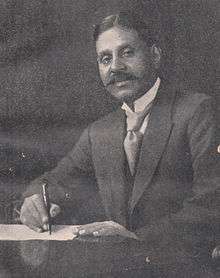Sachchidananda Sinha
| Sachchidananda Sinha | |
|---|---|
 | |
| President, Constituent Assembly of India | |
|
In office 9 December 1946 – 11 December 1946 | |
| Succeeded by | Dr. Rajendra Prasad |
| Personal details | |
| Born |
10 November 1871 Arrah, Bengal Presidency, British India |
| Died |
6 March 1950 (aged 78) Patna, Bihar, India |
| Nationality | Indian |
| Spouse(s) | Radhika |
| Alma mater | Patna University |
| Signature |
|
Sachchidananda Sinha (10 November 1871 — 6 March 1950) was an Indian lawyer, parliamentarian, and journalist.
Early life
Sinha was born on 10 November 1871 in Arrah, in Bengal Presidency (in present-day Bihar) into a well-to-do Kayastha family. He was educated in Patna and City College, Calcutta. He studied law in London to become a barrister. Following his return from London, Sinha began a movement for a separate province of Bihar with a small group of others. It was realized in 1911 with the formation of the Bihar and Orissa Province.[1]
Career
Sinha began his career as an advocate in 1893 practicing in the Calcutta High Court. He subsequently practiced in the Allahabad High Court starting 1896 and Patna High Court starting 1916.[2]
In his early years, Sinha was a member of the Indian National Congress, from 1899 till 1920, serving one term as secretary.[3] He participated in the Home Rule League Movement.
He was one of the vice-chancellors of Patna University and held the post from 1936 to 1944. He built the Sinha Library in 1924 in memory of his wife, Radhika.[1][4]
He was a member of the Imperial Legislative Council from 1910 to 1920 and the Indian Legislative Assembly. He was Deputy President of the Assembly in 1921.[3] He also held the office of the President in the Bihar and Orissa Legislative Council. He was appointed Executive Councillor and Finance Member of the Government of Bihar and Orissa, and, thus, was the first Indian who was ever appointed as a Finance Member of a Province.[3] Later, he also was a member of the Bihar Legislative Assembly. In 1946, he was named the Interim President of the Constituent Assembly of India on 9 December 1946.[3][5] He was replaced by Dr. Rajendra Prasad after indirect election on 11 December 1946.
A constituent college in Aurangabad is dedicated to him and was named Sachchidanand Sinha College, which was founded by Akhouri Krishna Prakash Sinha along with eminent[6] Gandhian Dr. Anugrah Narayan Sinha {later First Deputy Chief Minister of Bihar} before independence in the year 1943, who named it after Sachchidanand Sinha, as a living tribute to him, who was at that time 72 years of age.[7]
In January 2015, when U.S. President Barack Obama visited India, he was presented with a copy of the first telegram sent from the U.S. to India. The telegram was sent by then Acting Secretary of State Dean Acheson to Sachchidananda Sinha.[8]
Author
Sinha was a journalist and a writer. He was the publisher of the Indian Nation and editor of Hindustan Review. His works included Some Eminent Indian Contemporaries and Iqbal: The Poet and His Message (1947).
References
- 1 2 Dr. Sachchidananda Sinha: a maker of Bihar and modern India. by Kumar Himansu Madhukar.
- ↑ "Sachidananda Sinha Dead". The Indian Express. 7 March 1950. p. 1. Retrieved 17 May 2017.
- 1 2 3 4 Constituent Assembly of India Archived 6 July 2016 at the Wayback Machine.
- ↑ "Sinha library a victim of neglect". Retrieved 20 June 2012.
- ↑ "DR. SACHCHIDANANDA SINHA". Rajya Sabha, Parliament of India. Retrieved 20 June 2012.
- ↑ Congress a divided house in Anugrah babu’s hometown
- ↑ Sachchidanand Sinha College, Aurangabad has a proud history and bears the name of Dr. Sachichidanand Sinha.. Akhouri Krishna Prakash Sinha, the founder of this college.. Archived 18 August 2010 at the Wayback Machine.
- ↑ "First Telegram From US to India".